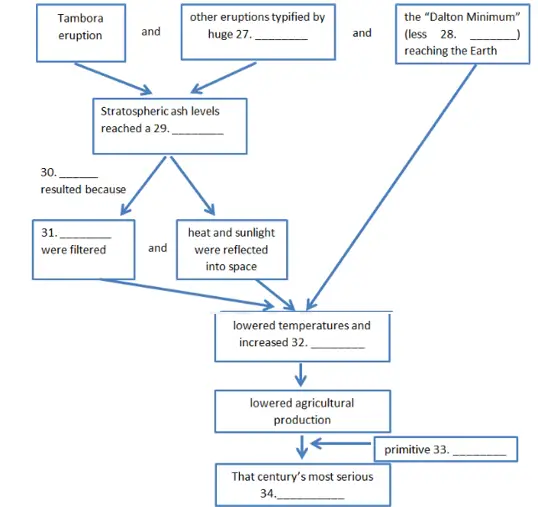1816 was a strange year indeed. In America, in midsummer, a ‘dry log’ covered the land so thickly that snow fell, and large parts of the country were gripped by an intense and lingering cold front. The situation was no better in Great Britain and Europe, where cool temperatures and wet weather persisted for months. Mary Shelley, author of Frankenstein, while holidaying in Switzerland, complained of ‘incessant rainfall’, a feeling which may have put her in the mood for writing her most famous work. But there were to be far more significant effects of what become known as the ‘year without a summer”.
But where did the summer go? The main culprit, surprisingly, was a volcano on the other side of the planet: Mount Tamhora. in Indonesia, whose eruption of the year before was of such colossal magnitude that it altered global climate. In the years leading to this, the mountain had experienced minor eruptions, but the 18.15 event was the culmination — a huge explosive outburst of the central volcanic vent with subsequent caldera collapse. Over 70,000 people in the vicinity were killed from lava flows, tsunamis, and pumice and ash falls. But more significantly, the eruption — now acknowledged as the largest in recorded history —ejected huge amounts of dust into the stratosphere. This atmospheric layer is the highest and most static, and least affected by rainfall, which means that it takes relatively long periods for volcanic dust to be washed out. If these dust particles are of fine composition, they are quickly blown around the globe, to remain there for years.
On a somewhat benign note, this air-borne ash resulted in beautiful pastel-coloured sunsets and extended twilights in Northern Europe. However, on a (quite literally) darker note, it set into motion a ‘volcanic winter’ due to the filtering of the sun’s rays, and the increased reflectivity of the atmosphere, where heat and sunlight are bounced back into space. But what is intriguing in this case is that even without the Tambora explosion, the period 1790 to 1830 was already one of the coldest on record. This period has officially become known as the ‘Dalton Minimum’, after John Dalton, a London-based meteorologist who noted that the sun at that time did not seem as active in its production of sunspots and solar flares. Whether there is a correlation between this and the average amount of solar radiation emitted is still unclear. If this does exist, the effect would be small—a fraction of a percent less, but, arguably, significant to our small planet orbiting so far away.
Adding further complexity to the issue, there had been other significant volcanic eruptions in the years prior to Tambora — in the Caribbean, Japan, and the Philippines — in which massive dust clouds were the characterising feature. Looking at the Philippino example, 1814 saw the most destructive eruption of Mt Mayon ever. Killing thousands, burying whole towns and villages, the volcano spewed out millions of tons of ash and rock into the high atmosphere. When we put all these factors together, the sequence is thus clearer. With the world already suffering from lower temperatures due to natural variations in the sun’s surface action, a series of severe volcanic eruptions occurred. As a result, the accumulation of ash in the stratosphere rose to a historic high, to which the mammoth Tambora explosion substantially added, sending a savage cold spike throughout the already cooler globe.
The consequences were dire. With the dramatic temperature swings, falling to near-freezing within hours, and with the sudden summer frosts and sustained drenching rainfall, all across the Northern Hemisphere, staple crops such as maize and wheat failed to mature, and much livestock were killed. With agricultural production already low due to the cooler preceding years, and with the rudimentary road systems of those times rendering the importation and distribution of emergency food supplies limited, this final blow was devastating. It resulted in widespread malnutrition, starvation, and outbreaks of diseases such as typhus and cholera. It created streams of starving refugees, large shifts of population, riots, looting of food warehouses, and other breakdowns of civic order. 100,000 people were thought to have died in Ireland alone, with many times that figure on the European continent. There was such mortality that the famine is now considered the worst of that century.
The question then is whether it could happen again. And the answer is, since it has happened many times before in geological history, a definite yes. The most extreme case occurred about 70,000 years ago, when the world’s largest known eruption took place at Lake Toba (relatively close to Tambora). This is thought to have plunged the planet into a decade-long volcanic winter, and triggered the onset of the last ice age, a deep freeze of the planet which lasted many tens of thousands of years, all of which, some speculate, just about wiped out the human race. We can rest in the assurance, however, that such events are extremely few and far between. You will certainly be able to enjoy your summer holidays, for a long time to come.
Questions 27-34
Complete the flowchart. Choose NO MORE THAN THREE WORDS from the passage for each answer.
A Year without a summer

Questions 35-40
Answer the questions.
Which location saw
A America
B Lake Toba
C London
D Northern Europe
E Philippines
F Switzerland
G Tambora
35. a positive effect of a volcanic eruption?
36. the biggest volcanic eruption?
37. scientific observation?
38. a series of eruptions?
39. buildings destroyed?
40. a book written?
